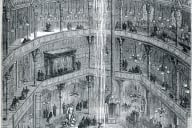You have /5 articles left.
Sign up for a free account or log in.
Last year, this column referred in passing to certain fanatical misreaders of the Second Amendment as “gun nuts.” The outrage so provoked was noticeably disproportionate (my topic wasn’t really gun nuttery, as such) but otherwise uninteresting. I didn't give it any mind. People on the Internet are constantly yelling about every little thing. Pay too much attention and you’ll go mentally deaf.
A couple of readers wrote in to say that the phrase had caused them more sorrow than anger. Previously, they had enjoyed Intellectual Affairs, but now they could tell I that I was in the grip of an irrational, left-wing prejudice against firearms. My use of “gun nuts,” one fellow explained, amounted to an act of “hate speech.”
How to respond? Should I promise to call them “Ballistic-Americans” in the future? Anyway, I forgot the whole thing until the recent massacre in Tucson. Compounding the sadness and horror of this event is the absolute certainty that it will make no difference whatsoever. The gun nuts won’t change. The politicians who play cutely with imagery of murder and calls for assassination won't quit doing so. And so we're now in the lull between rounds of mayhem.
Now, as it happens, I have done a little hunting in my time (without much effect on the wildlife population of East Texas, apart from the snakes) and have even wielded a handgun against beer cans. My correspondents' belief that I have a prejudice against firearms is mistaken. Sane people can use guns for sane reasons.
But that is, if anything, sufficient grounds for thinking that there should be only a very small and heavily regulated market in firearms. In a hyperdeveloped, highly urbanized country, the occasions for sane usage tend not to be growing -- while the likes of Jared Lee Loughner seem more common all the time. (Maybe it's all that digital screeching.)
A gun nut -- to clarify terms -- is a person who stockpiles weapons, eroticizes them, or thinks the Constitution includes the right to own, say, a machine gun. Anyone who regards it as a step toward totalitarianism to outlaw automatic or semi-automatic weapons (useless in hunting, absurd for target practice, and valuable only for mowing down crowds of people) is a gun nut. Only a sociopath will confuse the right to “life, liberty, and the pursuit of happiness” with the power to slaughter everyone in sight within a few seconds.
It has always been something of a puzzle to me that advocacy of gun control is thought to be a left-of-center political position. Friedrich Engels, of Communist Manifesto fame, was an avid sportsman and wrote with well-informed gusto about guns and ammo. He and his co-author believed that the building of socialism would require the masses to be well-armed. It is obvious that Malcolm X counted on more than verbal ammunition to win liberation. (Remember: if guns are policed, only the police will have guns.)
If anything, it seems as if gun control ought to be a quintessentially right-wing idea. Conservative thought tends to stress the values of social stability, natural hierarchy, and the role of the state in reinforcing the “inner check” on the passions of human beings tainted by original sin. Anyone who took those principles seriously would respect the need for legitimate authority to place some limit on the capacity of citizens to murder one another.
Mulling over these thoughts with my usual feeling of baffled futility, I turned to a new volume called Reload: Rethinking Violence in American Life (Vanderbilt University Press) by Christopher B. Strain, who is an associate professor of history and American studies at Florida Atlantic University. It grew out of a course he has taught, every other year, over the past decade. Some atrocity in the news always seemed to parallel what he was covering in the classroom. “There were so many school shootings -- and mall shootings and workplace shootings -- that I lost track of them in even-numbered years, when I was not teaching the course.”
The pervasiveness and regularity of that violence is numbing. To be an American is to take it for granted – to accept it as normal, more or less. Only a comparison with other countries will bring out how bad things are. “According to the Justice Department,” Strain writes, “the homicide rate declined in the United States from a spike of 10.5 per 100,000 in 1991 to 6.1 in 2000 (the lowest rate since 1967); by comparison, according to the World Health Organization, the homicide rates in France, Germany, and Great Britain in 2000 were 0.6, 0.8, and 0.9 respectively. Children in the United States are far more likely to be shot and killed than their counterparts in other industrial nations; the firearms homicide rate is sixteen times higher for American children. As alarming as such numbers may be, it is the U.S. homicide rate involving handguns that makes the United States stand apart internationally. In 1996, for example, handguns were used to murder 30 people in Great Britain, 106 in Canada, 15 in Japan, and 9.390 in the United States.”
Even after factoring in relative population sizes (the U.S. has roughly five times the population of the U.K., for example) this gap looks pathological. Most of Strain’s book is devoted to an assessment of how thoroughly American culture is saturated with imagery and invocations of violence, which he regards as both desensitizing and a form of incitement. The only way we can change this system of chronic and ubiquitous violence is to develop what he terms our viosense.
The latter is, I think a newlogism we should refudiate. In any case, “cultures of violence” don’t fire randomly into crowds, people with semiautomatic weapons do. The concluding pages of the book try to draw out the practical implications of his analysis, but soon run into a cul de sac. “We can create a peaceful, lawful nation in which the taking of human life is a shocking aberration instead of a common occurrence,” he insists, but the clearest suggestion he offers is warning labels on violent films, video games, and so on. There should be more and better licensing of guns, and we should possibly be “taxing ammunition in the same way that we tax cigarettes,” which would “make shooting someone cost prohibitive.”
I liked that idea better when Chris Rock used it in a comedy routine about how bullets should cost $5,000 each. Then you’d really have to want to kill a person, and there wouldn’t be any more innocent bystanders.
Unfortunately, reducing the violent content of our mass culture -- or trying to avert murderous behavior by imposing a “sin tax” -- seems like prescription for well-meaning ineffectuality. The place to start is to reduce the number of weapons in circulation. This won’t happen because their sale is so profitable. The industry certainly enjoys economies of scale. Strain cites recent figures showing 3 million firearms manufactured in the United States in 2004, with 2.9 million being for domestic consumption.
Until that changes, nothing else will. We’ll just keep having the same old arguments. Only the corpses will be new.




